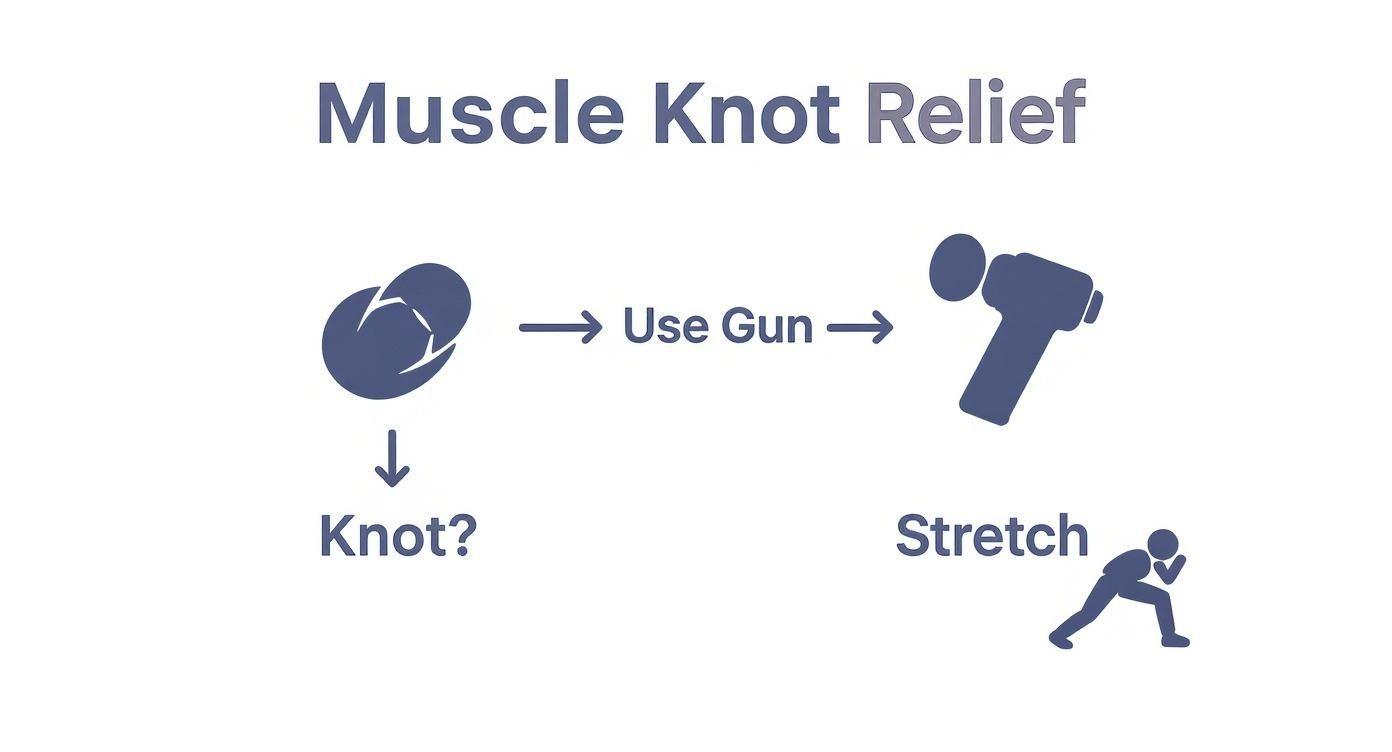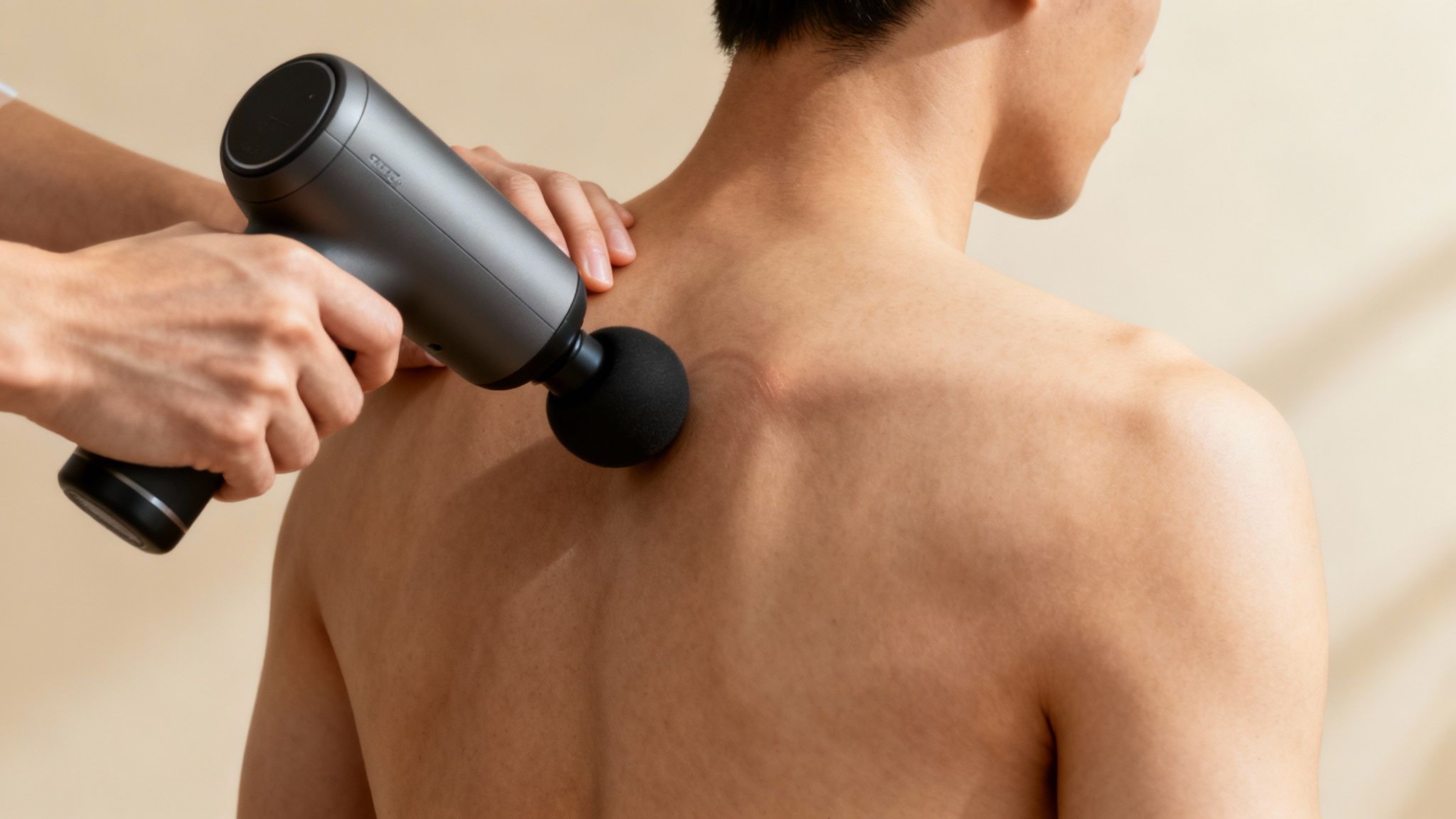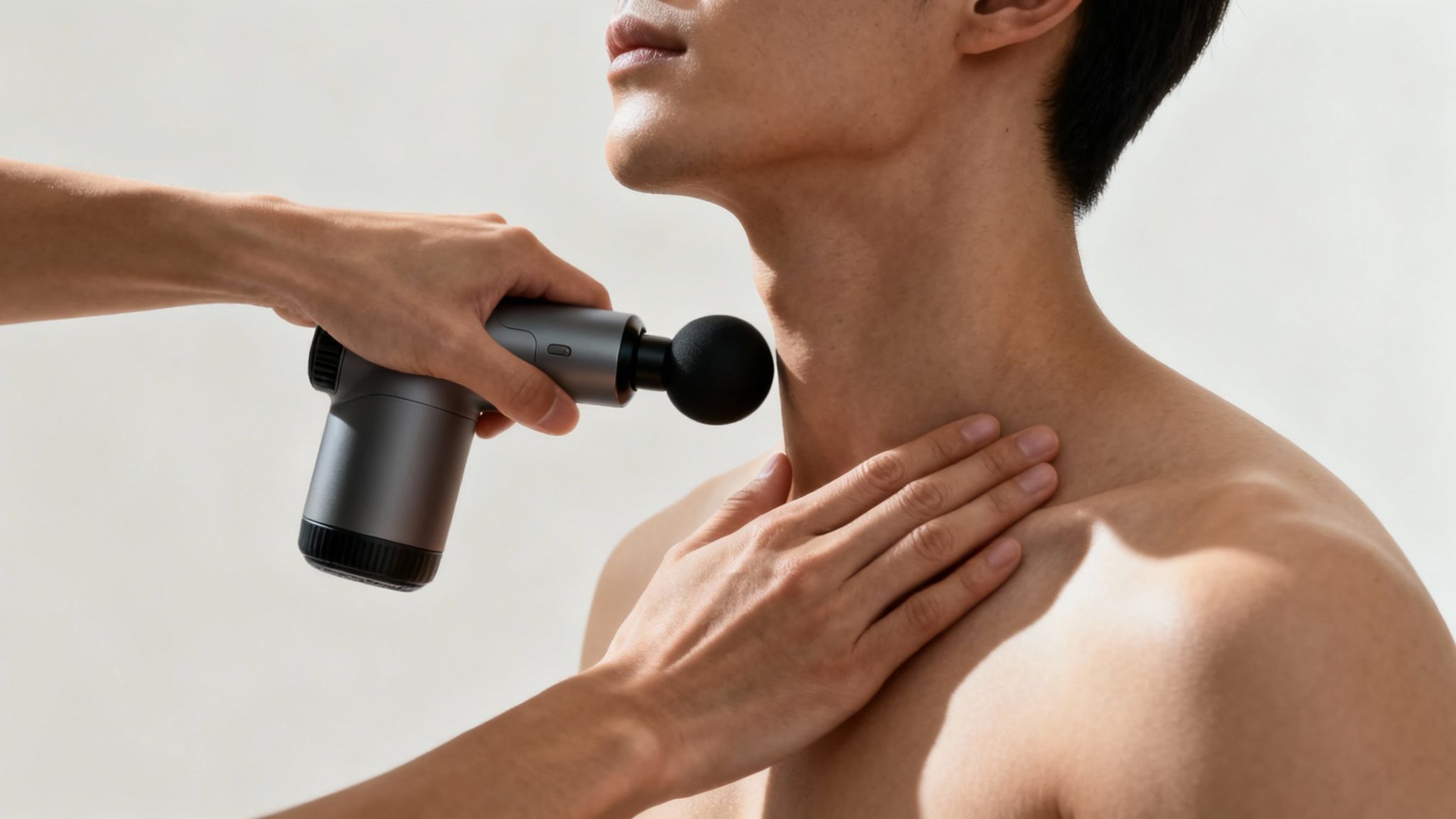
If you’ve ever had a stubborn muscle knot, you know how frustrating it can be. That deep, nagging ache just won’t quit. The good news is, a quality massage gun for muscle knots can deliver targeted relief right where you need it, all from the comfort of your home.
These powerful devices use rapid pulses to get deep into muscle tissue. This action helps support circulation and encourages those tight, angry muscle fibers to finally relax.
Why Do Muscle Knots Form in the First Place?
Those sore, tender spots you feel in your shoulders, back, or calves are technically called myofascial trigger points. Think of them as tiny, hyper-irritable knots in a taut band of muscle. They can show up for many reasons, from sitting at a desk all day to pushing it during a tough workout.
When your muscle fibers get overused or stuck in one position for too long, they can become "stuck" in a contracted state. This reduces blood flow, causing waste products to build up and leaving you with that all-too-familiar ache.
A few common culprits are often to blame:
- Repetitive Motions: Activities like typing, lifting heavy items, or even running can strain the same muscles over and over.
- Poor Posture: Slouching over a laptop or phone is a classic cause of chronic stress in your neck and shoulder muscles.
- Intense Exercise: When you push your muscles hard, you create microscopic tears. As your body repairs them, inflammation can sometimes lead to knots.
A massage gun helps tackle this problem directly. The percussive therapy works to manually address these adhesions, boost circulation, and send a signal to your nervous system to let that muscle relax. To get the full picture, you can learn more about what a massage gun does to support recovery.
"I used to get terrible knots in my upper back from working on my laptop. A few minutes with my Cryotex gun after work makes a huge difference. The relief is almost immediate."
- Jessica L., Chicago, IL
To round out your recovery routine, it’s also a great idea to explore some natural remedies for muscle soreness that work well alongside percussive therapy.
How to Choose the Right Massage Gun Attachment
Not all muscle knots are the same, so your approach shouldn’t be one-size-fits-all. Customizing each session is key to getting the most out of your massage gun for muscle knots. This means picking the right attachment head and speed for the specific area you're targeting.
For example, a deep, stubborn knot between your shoulder blades needs a different approach than general tightness in your calves after a run. For that shoulder knot, a bullet head on a low speed can deliver pinpoint pressure. For your calves, a wider flat head on a medium setting will do a better job of soothing the entire muscle group.
Picking Your Attachment and Speed
Your massage gun, like the Cryotex massage gun, comes with several interchangeable heads. Each one is designed for a specific purpose.
- Round Ball Head: This is your all-around MVP, perfect for large muscle groups like your glutes, quads, and back.
- Flat Head: Great for dense muscles that need more surface area contact, such as your pecs or hamstrings.
- Bullet Head: Your go-to for targeting deep, specific trigger points. Use it with care and not for too long in one spot.
- Fork Head: Specifically designed to work around sensitive areas you want to avoid, like your spine or Achilles tendon.
Figuring out which head to use is the first step. Our complete massage gun attachment guide breaks down every option in more detail.
Which Massage Gun Head to Use and When
To make it even simpler, here’s a quick reference guide to help you choose the perfect attachment for different muscle groups.
| Attachment Head | Best For | Example Muscle Groups |
|---|---|---|
| Round Ball | General, all-purpose use; large muscles | Glutes, Hamstrings, Quads, Back |
| Flat Head | Dense muscles; full-body recovery | Pecs, IT Bands, Lower Back |
| Bullet Head | Deep knots; trigger point therapy | Feet, Shoulders, Hands |
| Fork Head | Areas around the spine and joints | Neck, Spine, Achilles Tendon |
Having this cheat sheet handy takes the guesswork out of your recovery and ensures you're always using the right tool for the job.
This simple decision tree can also help you decide whether to grab your massage gun first or start with some gentle stretching.

As you can see, for active, painful knots, a massage gun is often the best first step, with stretching as a great follow-up to maintain mobility.
Not long ago, massage guns were niche tools for professionals, but now they’ve become a staple in home wellness routines. The market size was recently estimated between USD 0.5 billion and USD 0.7 billion, showing just how quickly people have adopted them. It's fascinating to see how technology like this is shaping the future of physical therapy and putting powerful recovery tools directly into our hands.
A Practical Method for Releasing Knots Safely

Alright, you've got the right attachment and you're ready to go. Effectively releasing a knot isn’t about brute force. The goal is to coax the muscle into relaxing, not hammer it into submission.
Start by prepping the area. A little movement goes a long way, so do a few gentle stretches for the muscle you're about to target. If you have a knot in your shoulder, this could be as simple as a few slow arm circles. This warms up the tissue and gets blood flowing, making it more receptive.
Finding and Floating Over the Knot
Once the muscle feels a bit warmer, turn on your massage gun for muscle knots to the lowest speed setting. Instead of jamming it directly into the painful spot, start by "floating" the head over the general area. Move it slowly with very light pressure, almost just grazing the skin.
This floating technique helps you map out the muscle and find the true center of the knot without causing it to tense up. As you glide the device, you’ll feel a spot that’s denser and more tender than the rest. That's your target.
A common mistake is digging into the most painful point right away with high pressure. This often backfires, causing the muscle to tense up as a protective response. Always ease into it gently.
This approach is a form of self-myofascial release. If you're interested in the science behind it, you can learn more about what myofascial release therapy is and how it works on connective tissues.
Applying Gentle, Sustained Pressure
After you’ve pinpointed the knot, it's time to settle in. Rest the massage gun head on that trigger point, applying just enough pressure so you feel it engaging the muscle. You don't need to push hard; let the percussion do the work.
Here’s a simple process that works every time:
- Hold and Breathe: Keep the gun on the knot for 30 to 60 seconds. As you hold it there, focus on taking slow, deep breaths. This helps signal your nervous system that it's okay to relax.
- Don't Grind It: Resist the urge to move the gun back and forth over the knot. That grinding motion can actually increase inflammation. Sustained, steady pressure is what gets results.
- Listen to Your Body: You should feel a "good pain"—uncomfortable, but in a relieving way. If you feel any sharp pain, back off the pressure or move the gun away from the spot.
Once your time is up, slowly lift the gun and float it over the area again for a few seconds. You can repeat this a couple of times, but don't overdo it on a single knot in one session.
Common Mistakes to Avoid When Using Your Massage Gun

Knowing what not to do with a massage gun for muscle knots is just as critical as getting the technique right. A few common slip-ups can easily turn a relaxing session into an irritating one.
The biggest mistake? Treating it like a jackhammer. More is not better. Going too hard, too fast is a classic error that makes muscles tense up defensively. Always start on the lowest setting and let the muscle get used to the sensation before increasing the intensity.
Staying Within the Safe Zones
Another key point is knowing which parts of the body to avoid. A massage gun is built for soft tissue, not for rattling bones or sensitive areas.
- Avoid Bones and Joints: Never run the massage gun directly over your spine, kneecaps, elbows, or other bony spots.
- Steer Clear of Nerves and Arteries: The front of your neck, your armpits, and the groin area are no-go zones. They contain major blood vessels and nerve clusters.
- Don't Use on Fresh Injuries: Hitting a recent sprain, strain, or badly inflamed area with a massage gun can make things worse. Let acute injuries calm down first.
The golden rule is simple: If it feels sharp or wrong, stop. Your body is your best guide, so learn to listen to it.
The popularity of these devices has exploded, especially in health-conscious regions. North America accounts for over 39% of the global market share for massage guns, thanks to a strong fitness culture. You can learn more about the massage gun market trends to see just how big this is. Finally, staying hydrated is key—it helps your muscles stay pliable and recover more efficiently.
How to Build Percussive Therapy Into Your Routine
A massage gun for muscle knots isn't just for when you're already sore. The real magic happens when you make it a regular part of your wellness routine. This helps you stay ahead of tightness and prevent knots from forming in the first place.
Think of it less like a quick fix and more like a daily habit for maintaining your body.
Creating Your Daily Ritual
Consistency turns your massage gun from a reactive tool into a proactive one. If you work at a desk, a quick five-minute session on your shoulders and upper back can help melt away "computer posture" tension.
For athletes and active individuals, the approach is a bit different:
- Pre-Workout Activation: Spend 60-90 seconds gliding the gun over the muscles you’re about to train. This isn't a deep massage; it's a quick pass to wake everything up.
- Post-Workout Recovery: After you’re done, a more focused ten-minute session can help flush out lactic acid, reduce soreness, and support your recovery.
"I keep my Cryotex by my home office desk. A quick session on my neck and shoulders in the afternoon is a total game-changer for my posture and tension headaches."
- Mark T., New York, NY
This shift toward proactive care is why the massage gun market recently hit a value of around USD 1.5 billion and is expected to grow by over 8% annually. You can discover more insights about massage gun market growth to see just how mainstream these tools have become.
Making percussive therapy a non-negotiable part of your day is the secret to keeping muscle tightness under control. Our guide on all massage gun benefits dives deeper into the long-term wins of consistent use. And if you're looking for the right tool, check out our Cryotex Massage Guns.
Your Top Massage Gun Questions, Answered
If you’re new to percussive therapy, you probably have questions. Here are straight-to-the-point answers to the most common things people ask about using a massage gun for muscle knots.
Is It Possible to Overdo It?
Absolutely. More isn't always better. Going too long on a single spot or pressing too hard can cause bruising and inflammation, which is the opposite of what you want.
The golden rule? Keep it short and effective. Stick to 1-2 minutes per muscle group. A full-body session shouldn't need more than 15 minutes to support recovery without overwhelming your muscles.
How Often Should I Be Using My Massage Gun?
This depends on your lifestyle. For general wellness, a few minutes every day is a fantastic routine.
If you’re active, you’ll want to use it more strategically.
- For Desk Workers: A quick 5-minute session targeting your neck, shoulders, and lower back can be a game-changer for daily stiffness.
- For Athletes: Use it for 1-2 minutes on the muscles you’re about to train, then a longer 10-15 minute session afterward to speed up recovery.
Consistency is everything. A little bit each day works far better than one long session once a week.
Can a Massage Gun Really Help With Knots?
Yes, it's one of the best tools for releasing stubborn muscle knots. The rapid pulses don't just feel good—they boost blood flow to the area, helping tight muscle fibers relax.
The percussion therapy signals your nervous system to let go of the tension holding that muscle hostage. The fresh circulation then helps flush out waste products that contribute to soreness.
Remember, it's a powerful tool, not a magic wand. For the best long-term relief, pair it with good hydration, regular stretching, and better posture. For a deeper dive, check out our post on all massage gun benefits.
Ready to feel the difference for yourself? BestMassageGun.com is where relaxation begins.
Shop the Cryotex Holiday Bundle — 4 FREE Turkish Towels at https://www.bestmassagegun.com